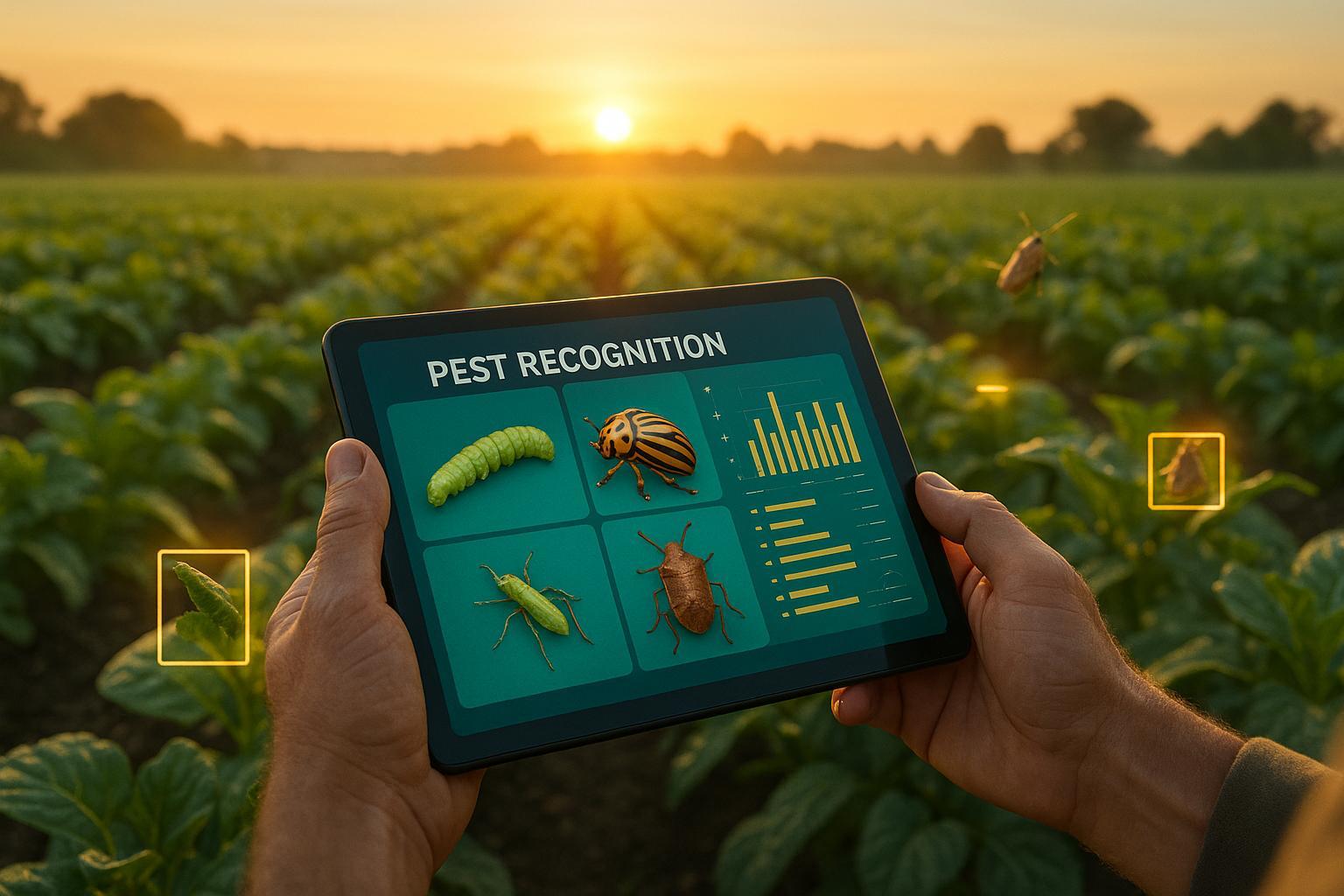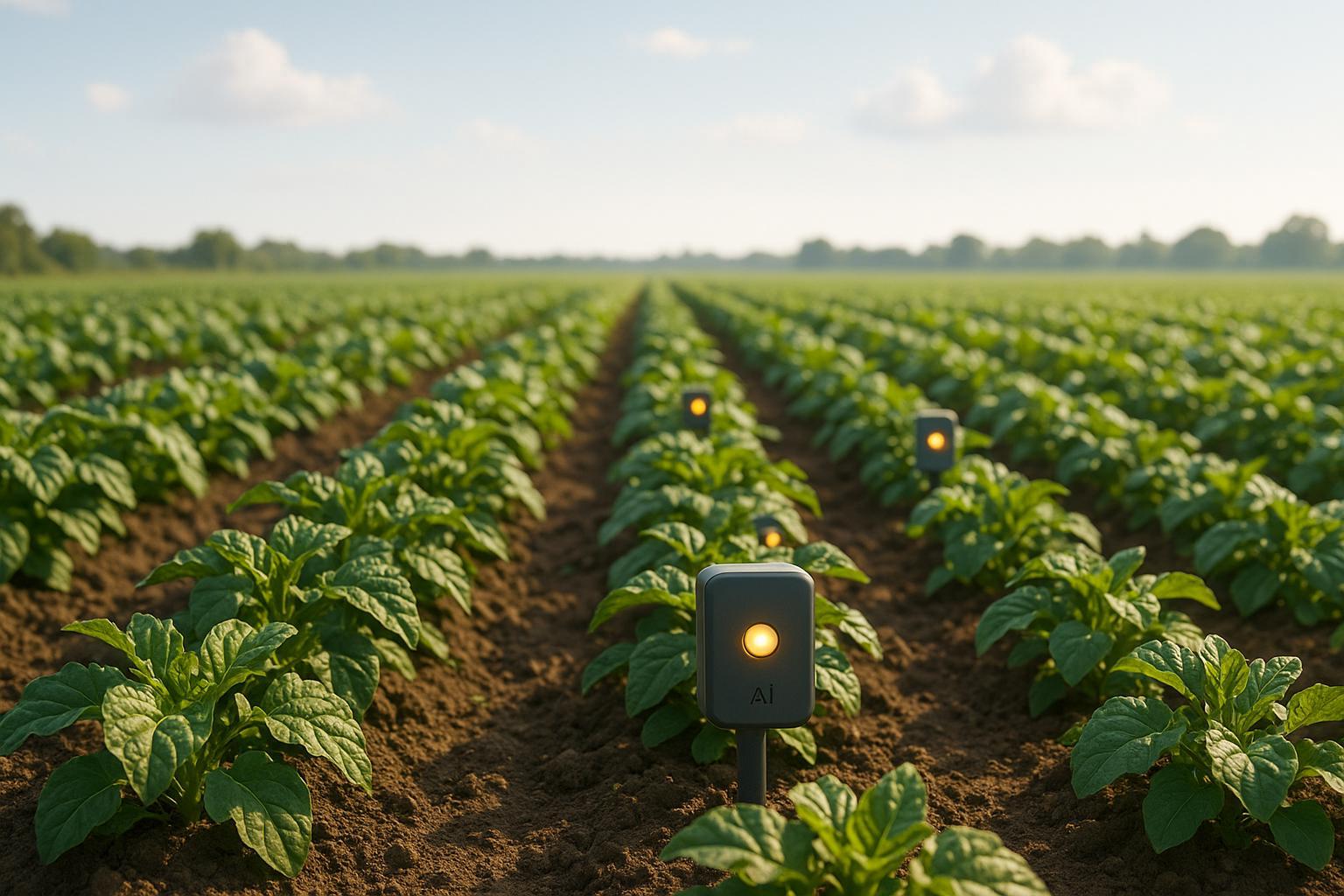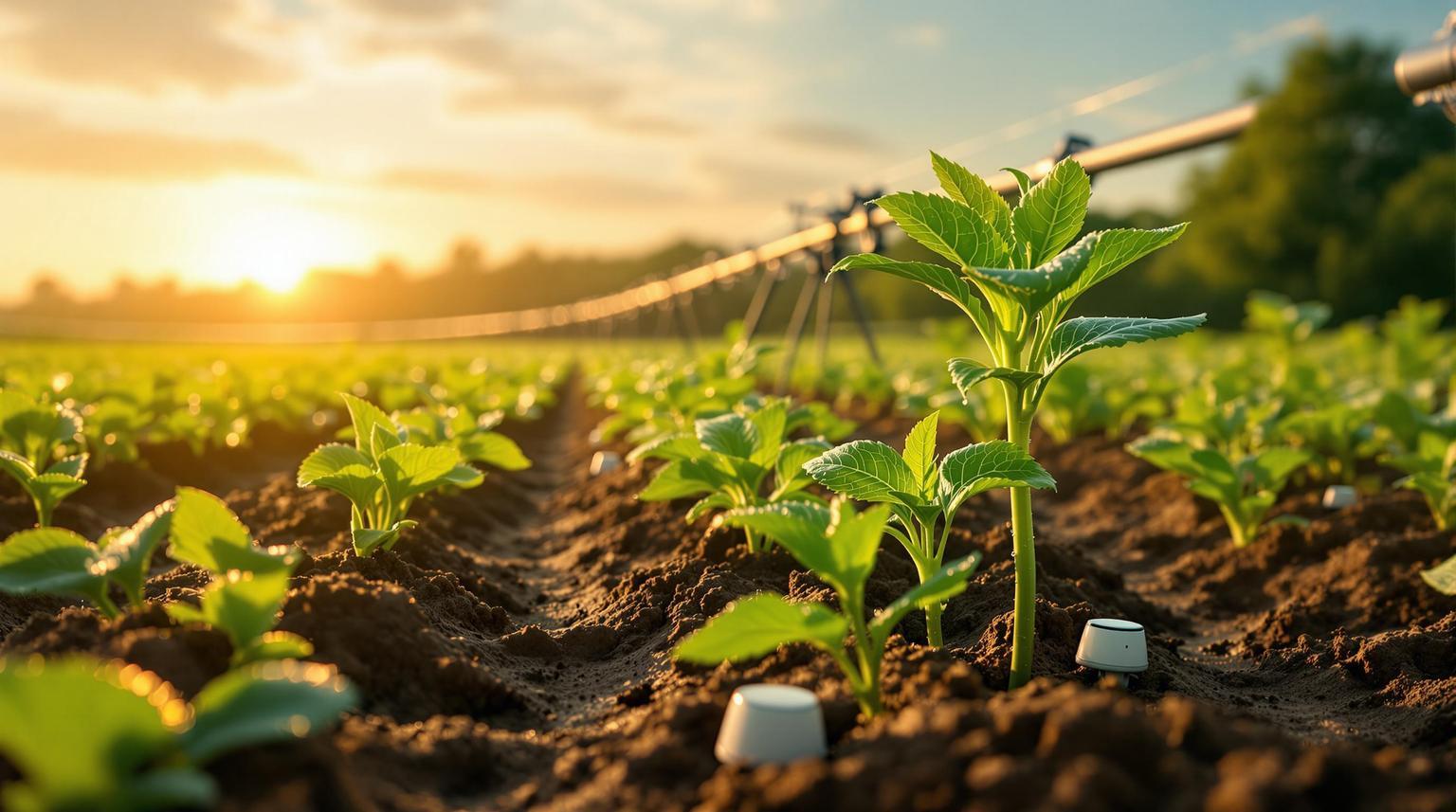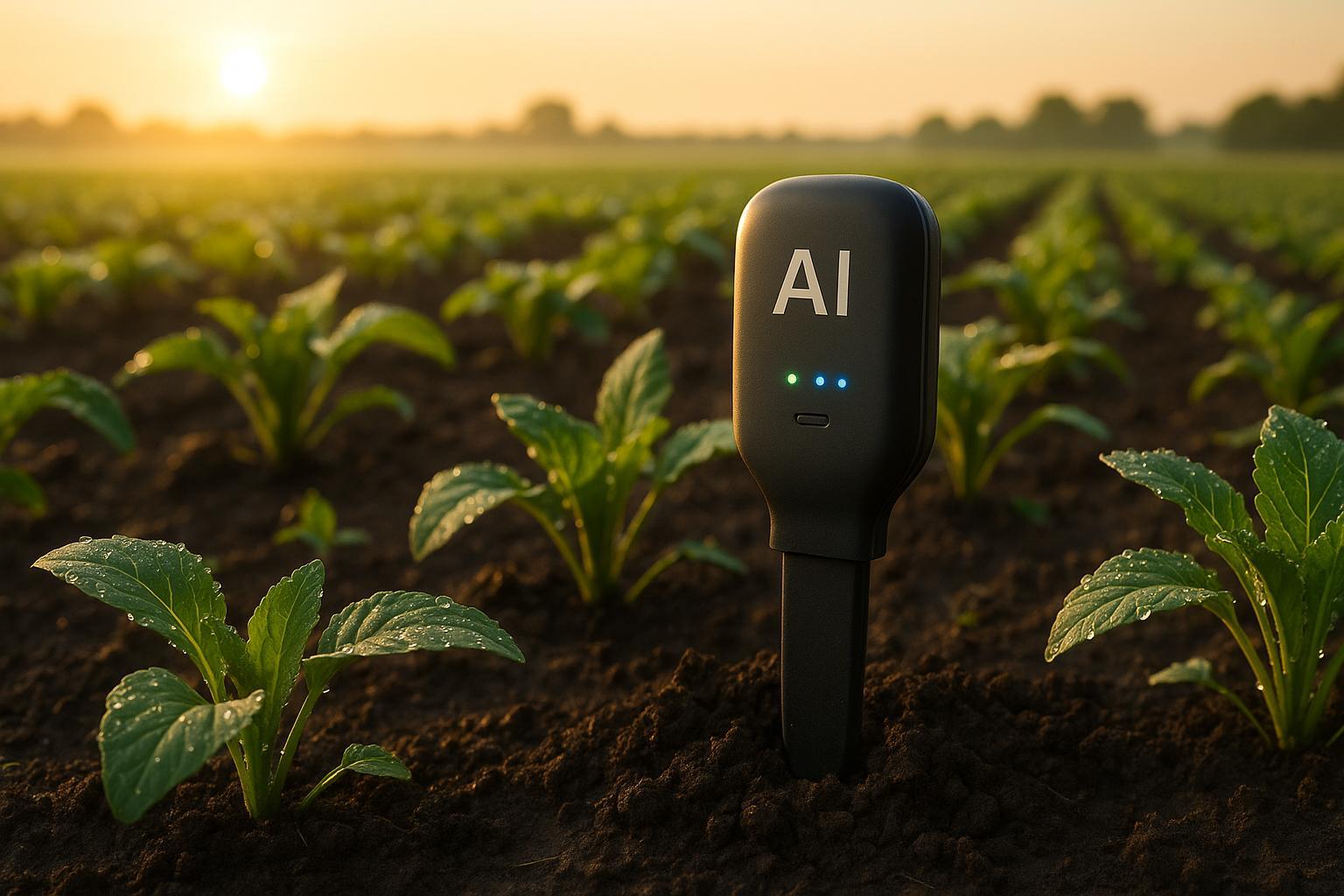AI for Soil Water Retention Analysis

AI is transforming soil water retention analysis, providing faster, more precise insights for farmers and gardeners. By analyzing soil properties, weather, and plant data, AI tools help optimize irrigation, reduce water waste, and improve plant selection. Key advancements include:
- Soil Water Retention: Understanding how soil holds water impacts irrigation and drought planning.
- AI Tools: Machine learning and computer vision analyze soil in hours, not weeks.
- Applications: AI maps soil retention across fields, supports irrigation strategies, and recommends drought-tolerant plants.
- Challenges: Data quality, localized soil variations, and seasonal changes still limit accuracy.
Platforms like AIGardenPlanner are making these tools accessible, offering tailored plant recommendations and garden designs based on soil and climate data. While challenges remain, AI is reshaping soil management and gardening practices.
Machine Intelligence for Estimating Soil Water Flux from Soil Moisture Data

Recent Advances in AI-Powered Soil Water Retention Research
Recent breakthroughs in artificial intelligence are reshaping how we assess soil water retention, a key factor in selecting drought-resistant plants. By moving beyond traditional lab methods, these AI-driven tools are speeding up predictions and offering more versatility in analyzing soil conditions across the diverse landscapes of the United States.
Hybrid AI Models for Soil Analysis
Hybrid models combine the strengths of AI and soil physics to improve moisture prediction. For instance, Long Short-Term Memory Physics-Informed Neural Networks (LSTM-PINN) bring together deep learning and fundamental soil physics equations. These models can also incorporate ensemble filtering techniques, which update predictions with fresh field data to boost accuracy over time. Field trials show that hybrid models deliver consistent results, even when dealing with the varied and complex soils found in the Midwest.
Machine Learning Algorithms in Soil Analysis
Machine learning algorithms like artificial neural networks (ANNs) are being used to analyze soil retention by factoring in variables such as particle size, density, and organic carbon levels. Other methods, like random forests and support vector machines, help uncover intricate, non-linear relationships between soil and water. By integrating these approaches into ensemble models, researchers can adapt to regional soil differences, tailoring predictions to specific areas across the U.S. These advancements are no longer just theoretical - they're already being tested and applied in real-world settings.
Field Applications and Validation
AI models are proving their worth in the field. Validation studies show that these tools can estimate soil water retention parameters with accuracy comparable to traditional lab results. In precision agriculture, for example, AI-driven soil analysis has been paired with variable-rate irrigation systems to conserve water without sacrificing crop yields. Greenhouses and nurseries are also benefiting, using AI to fine-tune watering schedules and minimize plant stress. By training these models with local data, their accuracy improves even further, making them highly effective for regional applications.
Methods for AI-Based Soil Water Retention Analysis
AI has brought a modern twist to soil water retention analysis by blending traditional soil science with machine learning. This combination allows for identifying patterns in soil moisture behavior and predicting how well soil retains water. The result? More accurate insights that can guide irrigation strategies and plant selection.
Key Data Inputs and Preprocessing
To analyze soil water retention, AI models rely on various soil properties like texture (sand, silt, and clay composition), bulk density (compaction levels), organic matter content, and chemical indicators such as pH and salinity. Environmental factors also play a role, including rainfall, temperature, humidity, and moisture readings from different soil depths.
Before feeding this data into AI models, preprocessing is essential. This involves normalizing data to ensure consistency across sources, filtering out anomalies to maintain accuracy, and using spatial interpolation to estimate soil conditions in areas where direct measurements are unavailable.
AI Techniques for Soil Analysis
Once the data is prepped, advanced AI methods step in to make sense of it all. Techniques like artificial neural networks, random forests, and support vector machines excel at uncovering complex, non-linear relationships within the data. Ensemble methods take it a step further by combining spatial and time-series analyses, allowing for adjustments based on landscape variations and seasonal changes.
These methods have practical applications, too. For example, tools like AIGardenPlanner use these insights to create personalized garden layouts that conserve water and suggest drought-tolerant plants. By turning raw data into actionable strategies, these AI-driven tools help gardeners and farmers make informed decisions tailored to their specific conditions.
sbb-itb-4d6a8dd
🚀 Ready to Reinvent Your Garden?
Join thousands of homeowners who have transformed their gardens using our AI design tool. Upload one photo to explore endless possibilities.
Get your AI garden designs →Impact of AI on Drought-Resistant Plant Selection and Garden Planning
AI is now playing a crucial role in selecting drought-resistant plants and designing gardens, especially in areas prone to water scarcity. By leveraging advanced soil analysis techniques, AI evaluates soil moisture levels and climate data to identify plants that thrive in specific conditions. This shift from basic soil assessments to actionable garden planning is reshaping sustainable landscaping across the U.S.
In states like Arizona, California, and Nevada, where water is a limited resource, choosing the right plants is critical. AI systems go beyond traditional hardiness zones by analyzing how soil retains water under varying conditions. This allows for more tailored planting strategies that consider the unique characteristics of each location's soil.
Climate-Appropriate Plant Recommendations
Modern AI tools provide highly specific plant recommendations by examining factors like soil texture, drainage capabilities, rainfall patterns, and temperature. These systems can differentiate between plants that merely survive in dry environments and those that truly thrive with minimal water. By incorporating real-time weather data and seasonal trends, AI ensures that plant selections align with natural moisture cycles, making landscaping efforts more effective and sustainable.
AI Tools for Garden Planning
These advanced plant recommendations are seamlessly integrated into digital garden design tools. For instance, platforms like AIGardenPlanner bring high-level soil science directly to gardeners. The platform’s AI Plant Advisor evaluates local conditions - such as climate zones, soil types, and weather patterns - to provide tailored plant suggestions.
In addition to plant recommendations, AIGardenPlanner offers practical resources like care instructions, planting schedules, and maintenance tips. This helps gardeners work with their soil's natural water retention properties for better results. With over 10,000 users worldwide and an average rating of 4.5/5, AIGardenPlanner is proving how AI-driven insights can lead to successful gardening experiences. The platform’s subscription-based model delivers rapid garden designs and personalized plant advice, making it an invaluable tool for anyone looking to create a sustainable garden.
Challenges and Future Directions in AI-Powered Soil Water Retention Analysis
Even with advancements in AI-powered soil analysis, there are still hurdles to overcome that limit its precision and widespread use. These ongoing challenges are driving further research and innovation in the field.
Current Limitations of AI Models
One of the biggest obstacles is data quality and availability. Soil databases are often inconsistent or incomplete due to nonstandardized collection methods. This lack of uniformity makes it harder for AI models to deliver accurate predictions across different regions.
Another issue is spatial variability. Soil properties can vary significantly even within small areas, like a single backyard. While a model might provide accurate predictions for a general soil type, it often misses these localized variations, which are crucial for precise garden-scale planning.
Validation and reliability also present challenges. Many models perform well under controlled lab conditions but struggle to replicate that success in real-world environments. This is because real-world conditions involve complex interactions between soil, weather, and management practices that are difficult to account for.
Lastly, seasonal changes complicate predictions. Soil water retention is not static - it shifts with the seasons. Yet, many existing models fail to incorporate these dynamic changes, treating soil properties as though they remain constant year-round.
Opportunities for Future Research
These challenges are paving the way for exciting new research directions.
One promising area is improved data collection and the integration of satellite imagery. Low-cost sensor networks could provide continuous, high-resolution soil data, while satellite observations of vegetation health, moisture levels, and topography could help create a more comprehensive understanding of soil-plant-water interactions across different scales.
The concept of personalized soil modeling offers another exciting possibility. Instead of relying solely on broad regional data, future AI tools could adapt to individual users by learning from their specific observations and outcomes. This could lead to highly tailored soil management advice, particularly useful for gardeners and small-scale farmers.
Cross-disciplinary collaboration is also proving valuable. By combining insights from soil science, plant physiology, hydrology, and climate science, researchers can develop AI systems that better predict how soil water retention impacts plant health under varying conditions.
Finally, advances in algorithm development are focusing on managing uncertainty and variability. Techniques like ensemble methods and probabilistic modeling could provide users with not just a single prediction but a range of possible outcomes, complete with confidence levels. This would help gardeners make more informed decisions.
The ultimate goal is to integrate these advances into practical tools for everyday use. As AI models become more precise and user-friendly, they could fundamentally change how people approach soil management. For example, platforms like AIGardenPlanner could offer more tailored garden planning and promote sustainable soil management practices, making advanced soil analysis accessible to anyone with a garden or landscaping project.
Conclusion
AI is reshaping how we approach soil water retention, offering quick and detailed insights that help farmers and gardeners make smarter decisions about plant selection, irrigation, and soil care. This evolution is opening doors to new research and practical techniques that were once out of reach.
With hybrid AI models and machine learning algorithms, it’s now possible to analyze the intricate relationships between soil, water, and plants without relying on costly lab tests. What used to require specialized expertise and resources is becoming accessible through intuitive digital tools.
One of the standout benefits of AI is its ability to support drought-resistant gardening. By identifying plants that thrive with minimal water, it helps reduce waste while boosting the success of gardens. This is increasingly valuable as climate patterns grow less predictable and water conservation becomes a pressing priority.
That said, challenges remain. Data inconsistencies and localized soil variations can still impact accuracy. Issues with data quality and model validation are hurdles, but advancements continue to improve the reliability of these tools. Platforms like AIGardenPlanner demonstrate how AI can be applied in practical ways, offering tailored plant recommendations based on factors like location, climate, and soil type.
Looking ahead, the future of agriculture and gardening will likely be shaped by AI technologies that combine scientific precision with everyday usability. As these tools become more refined and widely available, they’ll enable more efficient and sustainable practices - whether for a small backyard garden or a large-scale farm. The real game-changer lies in choosing tools that make advanced soil analysis simple and accessible for everyone aiming to cultivate vibrant, thriving landscapes.
FAQs
How does AI improve the accuracy of analyzing soil water retention compared to traditional methods?
AI is transforming the way we analyze soil water retention by leveraging advanced machine learning approaches like artificial neural networks (ANNs) and physics-informed neural networks (PINNs). These tools excel at identifying complex patterns in soil properties, enabling them to predict soil water retention curves with a higher level of accuracy.
Traditional methods often depend on limited datasets and simplified models, which can overlook key variables. In contrast, AI processes vast amounts of data and considers multiple factors at once. This leads to more precise predictions, offering valuable insights for farmers, gardeners, and researchers aiming to understand how soil holds water and supports plant health.
What challenges do AI systems face in predicting soil water retention, and how are researchers improving accuracy?
Predicting soil water retention is no easy task for AI systems. One major hurdle is the scarcity of high-quality data, as measuring soil water retention curves (SWRC) is both time-consuming and costly. On top of that, the natural variability in soil properties and the intricate ways soil and water interact add layers of complexity to the challenge.
To tackle these obstacles, researchers are turning to advanced tools like neural networks and machine learning models that integrate principles of soil science. These methods not only boost prediction accuracy but also enable the models to handle a variety of soil types, making them more dependable for real-world applications in agriculture and environmental management.
How can AI tools like AIGardenPlanner help gardeners choose the best drought-resistant plants for their soil and climate?
AI tools like AIGardenPlanner make choosing drought-resistant plants a breeze. They analyze factors like your soil's moisture levels, nutrient content, and local climate to recommend plants that will thrive in your garden.
By focusing on native and water-efficient species - think succulents, ornamental grasses, or Mediterranean plants - AIGardenPlanner helps you create a low-maintenance, water-smart landscape. These tailored suggestions not only conserve water but also encourage healthier plants and gardens better equipped to handle your environment's challenges.
🎨 Visualize Your Dream Garden Today!
Transform any outdoor space into a professional landscape design in minutes. Just upload a photo, choose your style, and let our AI do the rest.
Start your garden transformation now →Related posts
Related Articles

How to Plan and Build a Successful Raised Bed Vegetable Garden
Learn how to plan, design, and maintain a thriving raised bed vegetable garden with this comprehensive guide. Discover the benefits of raised beds, how to choose the right location and materials, what to plant, and how to care for your garden.

AI Datasets for Pest Recognition: Explained
Explore how AI datasets enhance pest recognition in agriculture, tackling challenges and leveraging synthetic data for improved crop management.

How AI Sensors Improve Seasonal Plant Monitoring
Explore how AI sensors revolutionize plant monitoring, enhancing resource efficiency, boosting yields, and enabling early disease detection.

How AI Improves Soil Moisture Data Analysis
Explore how AI enhances soil moisture analysis, optimizes irrigation, and promotes healthier plants while conserving water in agriculture.

Top Plants for Carbon Sequestration
Explore how selecting the right plants for your garden can enhance carbon sequestration, support local ecosystems, and promote sustainability.

How AI Soil Sensors Monitor Moisture and Nutrients
Explore how AI soil sensors enhance farming efficiency by monitoring moisture and nutrients, optimizing irrigation, and boosting crop yields.